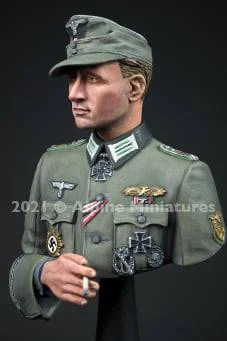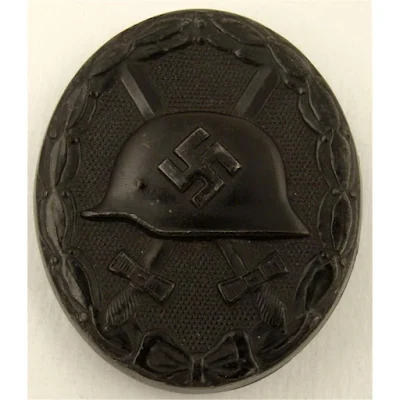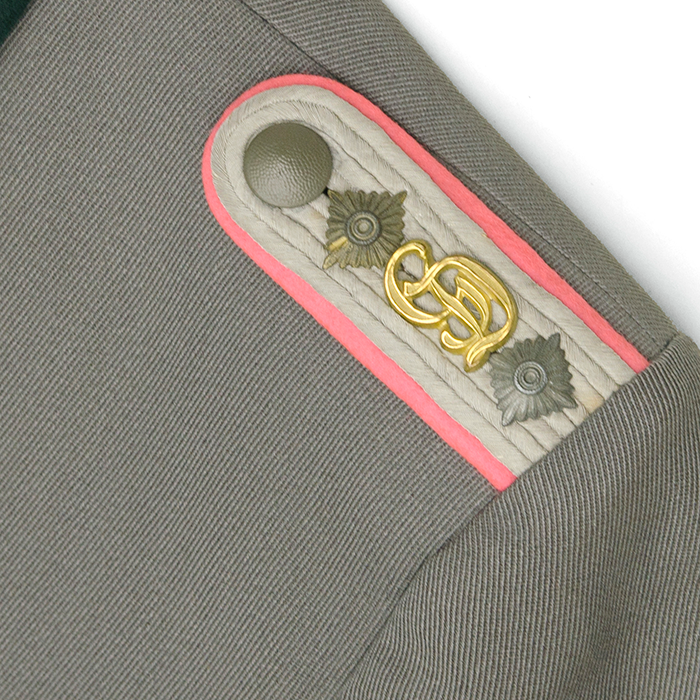Two new figures in 1/16th scale from Alpine Miniatures in January...
Alpine Miniatures has been busy over the Christmas break, with two new figures in 1/16th scale released this month - one being a full-bodied sculpt, the other being a bust. Both of them feature German soldiers of the Second World War, and both feature exquisite detail. We will look at them both in our preview...
28. Jaeger Division "Iron Cross Division"
Kit No #16042
1/16th scale
Sculpture by John Rosengrant
Box Art by Calvin Tan
Product Link on the Alpine Miniatures website
The full-bodied soldier represents a man from the 28. Jaeger Division - (this lineage giving it the divisional nickname of the Eisernes Kreuz Schlesische Division, the 'Iron Cross Silesian Division') by its troops. The 28. Jäger-Division was formed on 1 July 1942 by the redesignation of the 28. Leichte Infanterie-Division and fought through the war until surrendering to the Soviets in 1945 in the guize of the Gebirgs-Artillerie-Regiment 28.
28. Jaeger Division fought on the Kerch Peninsula and in the final assault on Sevastopol. It was transferred to the 11. Armee in the north and was due for transfer to Finland. The division fought near Demyansk in late 1942 and in January and February 1943, in the second battle of Lake Ladoga. It absorbed the remnants of the disbanded 1. Feld-Division (L) in January 1944. In July 1944, the division fought in the failed attempt to prevent the encirclement of the bulk of 4. Armee near Minsk. It suffered heavy losses during the retreat into Poland and the fighting near Brest-Litovsk. Less than 1.000 men remained of the division when it surrendered to the Red Army in East Prussia in May 1945.
This 1/16th scale figure was sculpted originally by the very talented John Rosengrant, and the painted up version on the box art is by the equally gifted Calvin Tan. He some, like all of Alpine Miniatures figures, with two head choices, both with the same face, but each wearing different headgear. The figures below has the cloth M43 Feldmütze Infantry.
In 1942 the "Jägerabzeichen" insignia was introduced on both uniforms and field caps., and this field grey cap features the hand-sewn trapezoidal Heer insignia on the front, as well as the distinctive silver metallic “Jäger-Divisionen” insignia on the left side. The Jägerabzeichen - the Insignia of the Hunters - that replicated three branches of oak leaves on a stem with an acorn at the bottom.
While a panzerfaust is slung over his shoulder, you can see from these shots from he back of his thick, double-sided parka that folds and falls down at the hood, while the thick layers are pushed aside by the "Y" shaped harness that the soldier's gear hangs from. His bread bag, water canteen hanging from his leather belt on the rear.
The other headgear choice features the ubiquitous M43 steel helmet. No introductions needed here, this was the standard uniform helmet for German troops during WWII. In the front of his parka, you can see his scarf protecting him from the cold, his stick grenade tucked into the soldier's belt, the Sturmgewehr 44 and ammunition in three pouches either side of his body that are made from cloth - usually recycled from other clothing.
These reversible winter parka that he wears were a standard-issue item and were distributed to all EM/NCO’s for the winter season, (September to April), with other winter garments and were to be returned to the units clothing depot in April for storage, repair and cleaning to be reissued the following September. Originally Officers and senior NCO’s responsible for purchasing their own uniforms and headgear were required to purchase the new winter garments until regulations of December 1942 extended the issue winter clothing to all ranks in the colder theatres of operation. Although the suits proved quite effective, they were very difficult to keep clean and launder which resulted in regulations dictating that the white side was only to be worn on the exterior when absolutely necessary.
The helpful man he is, Clavin Tan (who painted the boxart version) has included the painting guide he used for his figure for all of us mere mortals :-)Captain "Grossdeutschland" Bust
Kit No #B005
1/16th scale bust
Sculpture by Mike Good
Conversion by Taesung Harmms
Box Art by Matt Wellhouser
Product Link on the Alpine Miniatures website
The second figure from Alpine Miniatures that has just been released has a little less of a fuller figure about him, not that the bust that has been created lacks any of that Alpine detail. The bust is sculpted by Mike Good (another talented man) and in this case converted by the boss of Alpine, Mr Taesung Harmms, into a heavily decorated Captain of the "Grossdeutschland" division of the German Army of WWII.
The Panzergrenadier Division "Großdeutschland", also commonly referred to simply as Großdeutschland or Großdeutschland Division, was an elite combat unit of the German Army (Heer) that fought on the Eastern Front in World War II.
The logo of the Panzergrenadier Division "Großdeutschland"
Originally formed in 1921 it was known as the Wachregiment Berlin[3] and served as a ceremonial guard unit and by 1939 had grown into a regiment of the combined Wehrmacht German armed forces. The regiment would later be expanded and renamed Infantry Division Großdeutschland in 1942, and after a significant reorganization was renamed Panzergrenadier Division Großdeutschland in May 1943. In November 1944, while the division retained its status as a panzergrenadier division, some of its subordinate units were expanded to divisional status, and the whole group of divisions were reorganized as Panzerkorps Großdeutschland.
Just like his cousin we just looked at in 1/16th scale, this figure bust comes with two head choices, the cloth M43 Feldmütze, and the peaked officer's cap, the Schirmmütze with small goggles around the headband. It is your choice with this soldier out of both of these solid choices. On his chest you can see the two ribbons from his buttonhole - an Iron cross second class and eastern front service ribbon.
We see on his right shoulder we see a tank destruction badge, while on the lower left on his officer's tunic below his right breast pocket is the eye-catching German Cross in gold. The colour of the laurel wreath around the swastika, or in silver depending on what you would like to depict him in.
These could come embroidered or in metal moulded. The former being an award for repeated acts of bravery or repeated outstanding achievements in combat, the latter being for multiple distinguished services in war efforts and was considered a continuation of the War Merit Cross with swords. Here is one in real life, the German Cross in Gold (left) and Silver (right).
The tank destruction badge in silver was instituted by Adolf Hitler on the 9th March 1942 to honour individuals who single-handedly destroyed an enemy tank with handheld weapons. This award was made retroactive to the beginning of the invasion of the Soviet Union (22nd June 1941
The right sleeve is included onto this bust, it has an officer quality hand embroidered in silver wire Großdeutschland sleeve band, while in his hand he has a lit cigarette.
The regulatory cuff strap (Großdeutschland Ärmelstreiffen) for troop members of the "Grossdeutschland" division was 400 mm long and 30 mm wide and made of black wool with the writing "Großdeutschland", woven in wool yarn.
On the top left-hand side breast of the figure (right as we are looking at him) is the close combat clasp which could be in gold, silver or bronze depending on the award.
Directly below that are three ribbons,, I have been informed that they are the iron cross second class, long service medal and Commemorative Medal of March 13TH 1938 ribbon.
Below that and under his buttoned pockets are not only his Iron Cross which is, of course, easy to make out, but underneath that is the oval-shaped Infantry assault Badge to the lower left and what looks to me like the smaller, circular Wound Assault Badge which could also be in gold, silver or black. This guy sure was in the thick of the action!
From his shoulder boards (and the title of the bust) you can tell he is a Captain or Hauptmann from the Großdeutschland Division. On June 12TH 1939 the Wachregiment was given Infantry regiment status and renamed Großdeutschland Infantry Regiment with its personnel eventually going on to form the cadre of the elite Panzer Division Großdeutschland in May 1942.
On June 20TH 1939 special uniforms and insignia were introduced for all Großdeutschland personnel including the distinctive cuff title and shoulder board/strap cyphers. Although the unique "GD" uniforms were placed in storage until altered and reissued in 1944, personnel of the regiment did utilize the shoulder board/strap cyphers and the distinctive cuff title through-out the war. Regulations decreed that the shoulder board/strap cyphers were embroidered in the branch of service colour for EM’s and Junior NCO’s, in silvered metal for Senior NCO’s and in gilded metal for Officer’s ranks.
The badge on this left arm I could not place until I emailed Alpine and found that it is called the "Kuban Campaign Shield". The Kuban Campaign Shield was instituted by Adolf Hitler on September 21ST 1943, as the last official campaign shield to see production and issue during the war. The shield was designed for award to personnel, in all branches of service, who had served in the defensive battles in the Crimean peninsula from February 1943 onward. Criteria for award of the shield dictated that personnel had to have been involved in at least one major engagement, served two months in the theatre or had been wounded in battle. The shields were bestowed by Knight’s Cross, Oak-leaves and Swords winner, Generalfeldmarschall Ewald von Kliest as the commanding officer of Army Group South Ukraine.
Oberleutnant Bruno Kikillus from GD, wth similar sideboards, medals, tunic and officer's cap to our bust.
From the rear you can see the figure comes with a stand that secures to the torso, all you need is a base to plant him on...
You can see more about these figures, and where to purchase him on the Alpine Miniatures Website










































